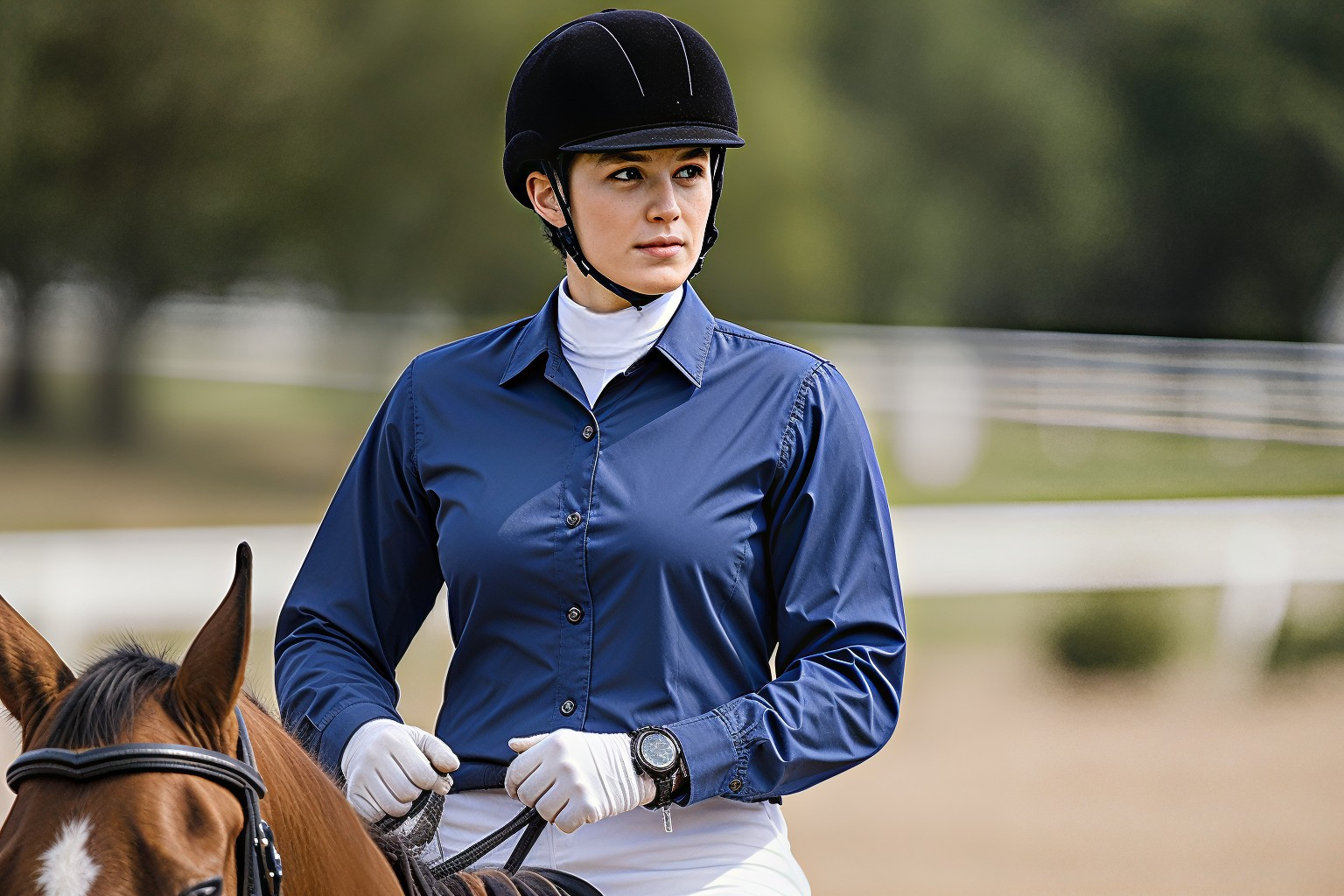You know that moment—midway through your second lesson of the day, sweat starting to pool under your arms, your shirt clinging to your back like a second skin, and you’re still expected to look polished for your student’s parents watching from the sidelines? Yeah. I’ve been there. And honestly, it’s not just about comfort. It’s about confidence. When your riding shirt rides up, bunches, or worse—starts to smell after two hours in the sun—it’s hard to focus on what really matters: your horse, your form, your presence in the saddle.
That’s why custom equestrian shirts aren’t just a fashion statement. They’re performance gear. And the secret isn’t in the cut or the logo—it’s in the fabric. Most riders still reach for cotton because it feels soft at first. But by the end of a long day at the barn, they’re regretting that choice. At Fexwear, we’ve spent years testing, tweaking, and listening to riders—from weekend warriors to Grand Prix competitors—about what actually works when the pressure’s on.
In this article, we’re going deep. Not just into what fabrics work, but why they work, how they feel after five washes, and which ones actually survive a muddy cross-country run. We’ll break down the science without the jargon, share real rider stories (including some of our own design flops), and help you choose the right material for your riding life—whether you’re schooling in the rain or stepping into the show ring under stadium lights.
Let’s stop guessing. Let’s get real about what you wear in the saddle.
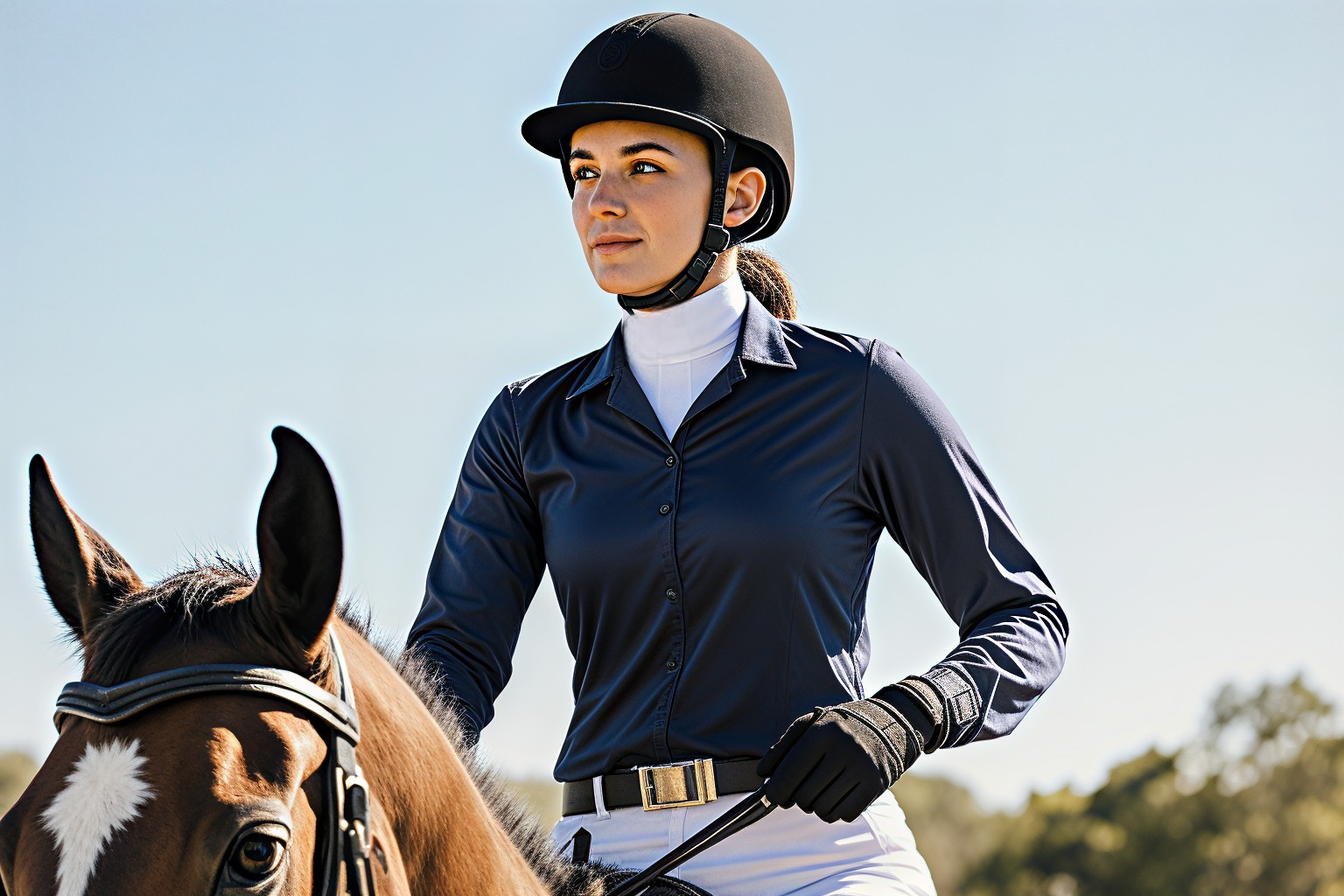
Why Your Riding Shirt Should Work as Hard as You Do
Let’s be honest: most equestrian apparel is designed to look good in photos, not to perform in real life. I used to think, “As long as it’s got a nice collar and a subtle logo, I’m golden.” Then I spent a summer coaching at a camp in Texas, where the heat index regularly hit 110°F. By noon, my “professional” cotton-poplin shirt was soaked, wrinkled, and stuck to my back like a damp dishrag. I looked anything but professional.
That was the wake-up call. Because here’s the truth: your riding shirt is part of your safety and performance system. Think about it. You’re in the saddle for hours. Your body is generating heat, moving constantly, dealing with friction from the saddle, wind, sun, and yes—sweat. If your shirt can’t handle that, you’re fighting an uphill battle before you even mount up.
And it’s not just about staying dry. Poor fabric choices lead to chafing, overheating, distraction, and even odor buildup that can bother your horse. Ever had your mare toss her head every time you reach forward? Could be the synthetic smell of a cheap, off-gassing polyester blend.
At Fexwear, we started asking: What if riding shirts were built like athletic wear? Not just styled like it, but engineered for it. That’s when we shifted from “custom shirts for riders” to “performance-first custom equestrian shirts.” And the difference? Night and day.
So before we dive into specific fabrics, let’s talk about what actually matters when you’re in the saddle.
The 7 Non-Negotiables of a High-Performance Riding Shirt
You don’t need a lab coat to understand fabric performance. You need real-world experience. After testing over 40 fabric blends with riders across disciplines, here are the seven things we now consider non-negotiable:
1. Moisture-Wicking That Actually Works
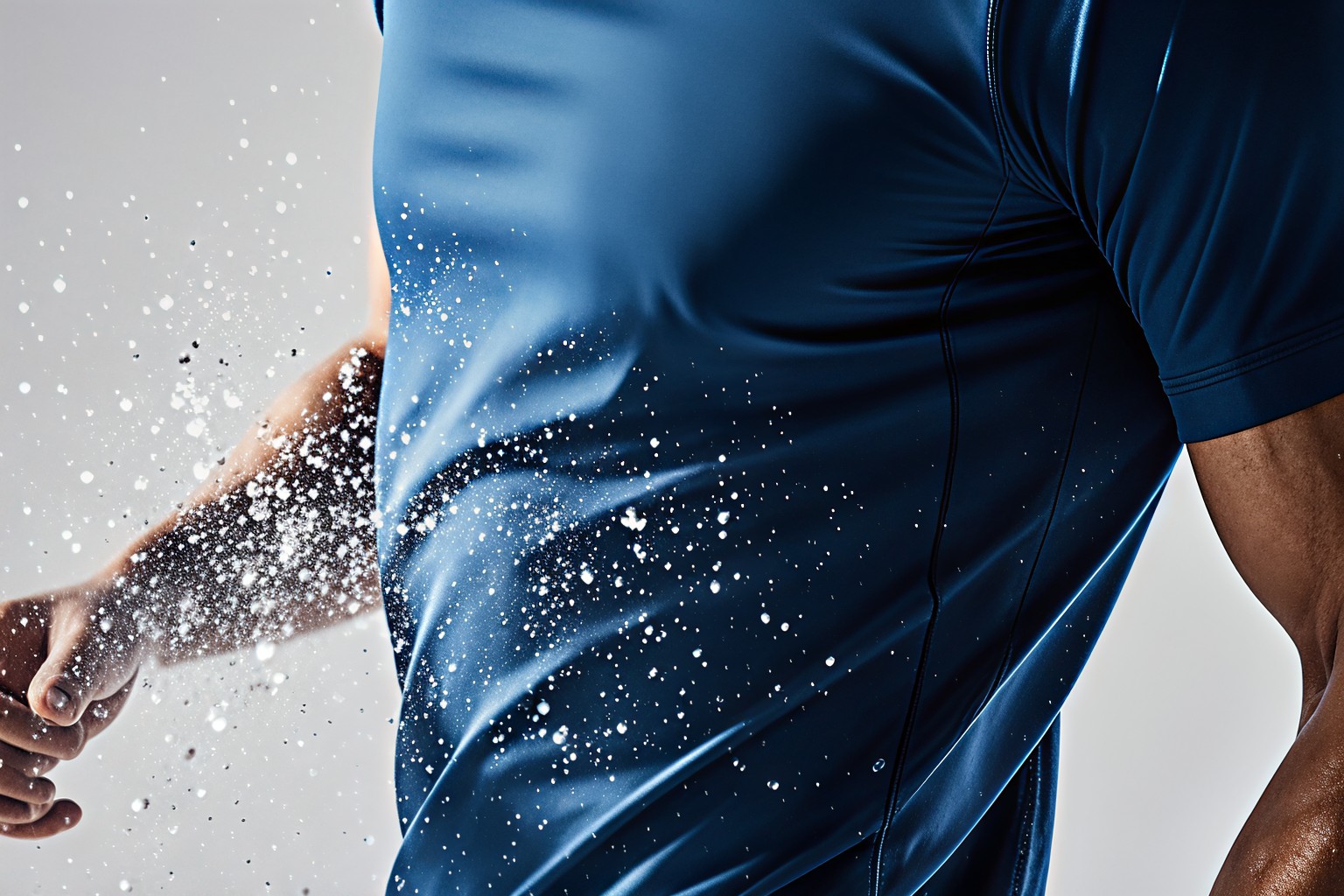
It’s not enough for a shirt to “claim” moisture-wicking. It has to prove it. Real moisture-wicking pulls sweat away from your skin and spreads it across the fabric surface so it evaporates fast. Not all synthetics do this well. Some just absorb sweat and hold it—basically turning into a damp sponge. We learned this the hard way with an early prototype that used a cheap polyester blend. Riders loved the look… until they wore it in humidity. Big mistake.
2. Breathability Without Sacrificing Structure
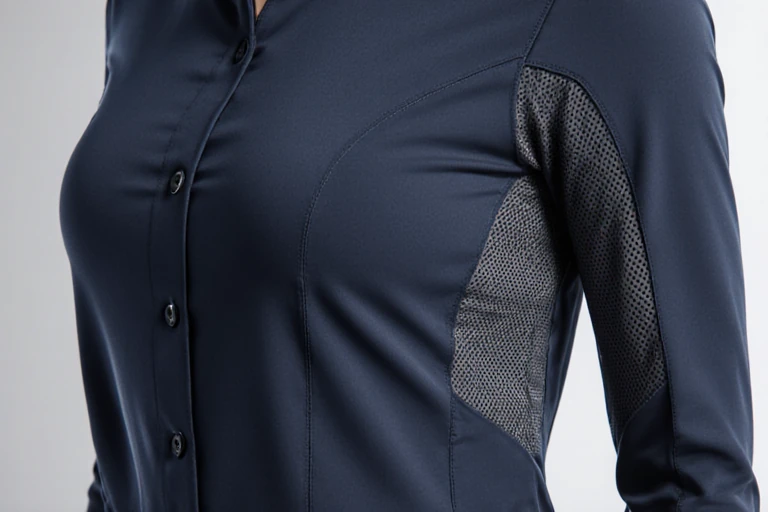
You want airflow, but you don’t want your shirt flapping in the wind like a sail. The best fabrics use micro-perforations or mesh paneling in strategic zones—underarms, back yoke, side seams—so heat escapes without compromising the clean, tailored look equestrians expect.
3. 4-Way Stretch That Moves With You
Riding isn’t static. You’re posting, reaching, bending, turning. If your shirt resists movement, it fights your ride. We now use 12–15% spandex in most of our performance blends, but it’s not just about stretch—it’s about recovery. A good fabric stretches, then snaps back. No bagging, no sagging.
4. Odor Resistance That Lasts
Ever open your laundry basket and gag? That’s bacteria feeding on sweat in your clothes. Antimicrobial treatments—like silver-ion or Polygiene®—stop that cycle. And yes, it matters for your horse. Horses have sensitive noses. A smelly rider can be a distracting rider.
5. UPF 50+ Protection
You’re outdoors for hours. UV damage is real. A standard cotton shirt might offer UPF 5–10. Our goal? UPF 50+, blocking 98% of harmful rays. And it’s not just about color—dark fabrics absorb heat. The right performance fabric reflects UV while staying cool.
6. Durability That Survives the Barn
Horses are tough on gear. Grooming buckets, saddle racks, hay bales—they all take a toll. We test our fabrics for abrasion resistance, pilling, and colorfastness. One of our testers, a working student in Kentucky, wore the same Fexwear shirt for 18 consecutive days—lessons, chores, trail rides. It still looked showroom-ready.
7. Shape Retention After Washing
Nothing kills confidence like a shirt that shrinks or sags after two washes. Performance fabrics should last. We’ve had customers tell us their Fexwear shirts look better after 50 washes than their old ones did after five.
Bottom line? If your riding shirt doesn’t check at least five of these boxes, it’s not a performance shirt. It’s a costume.
The Best Performance Fabrics for Equestrian Shirts (And the Ones to Avoid)

Let’s cut through the marketing fluff. You’ve seen terms like “technical fabric,” “athletic knit,” “cool-dry weave.” But what do they actually mean? Let’s break down the real players in the equestrian performance fabric game.
Polyester Microfiber: The Workhorse
This is the backbone of most performance riding shirts. Lightweight, quick-drying, and durable. But not all polyester is created equal. Cheap versions feel plasticky and trap heat. High-quality microfiber polyester—like the kind we use in our Core Line—has a soft hand, excellent drape, and superior wicking. In practice, we’ve found it outperforms cotton in every category except initial softness. And after five minutes in the saddle? Cotton loses.
Nylon-Spandex Blends: Tough and Flexible
Nylon is stronger than polyester and more abrasion-resistant. When blended with 10–15% spandex, you get a fabric that stretches, recovers, and lasts. Ideal for jumping riders or anyone doing high-movement work. Downside? Slightly less breathable. But for durability, it’s unmatched.
Merino Wool: The Natural Wonder
I’ll admit—I was skeptical. Wool? In summer? But merino is different. It’s ultra-fine, non-itchy, and naturally regulates temperature. It wicks, resists odor, and even insulates when wet. Perfect for base layers or cooler climates. Not ideal for full shirts in hot weather, though. It’s heavy and slower to dry.
TENCEL™ (Lyocell): Eco-Luxury
Made from sustainably harvested eucalyptus, TENCEL™ is silky, breathable, and biodegradable. It drapes beautifully and feels amazing against the skin. We blend it with recycled polyester to boost durability. Riders who value sustainable equestrian clothing love this fabric. It’s not the most durable for rough use, but for dressage or coaching? Perfect.
Polypropylene: The Hidden Hero
Rarely used alone, but killer in base layers. It doesn’t absorb moisture—it pushes it away. Great for layering in winter. Smells weird when new, but performs like a champ.
And the one to avoid? Cotton. I know, it’s everywhere. But cotton absorbs sweat, holds it, takes forever to dry, and loses shape fast. In high-performance riding? It’s a liability.
How Fabric Choice Changes by Discipline
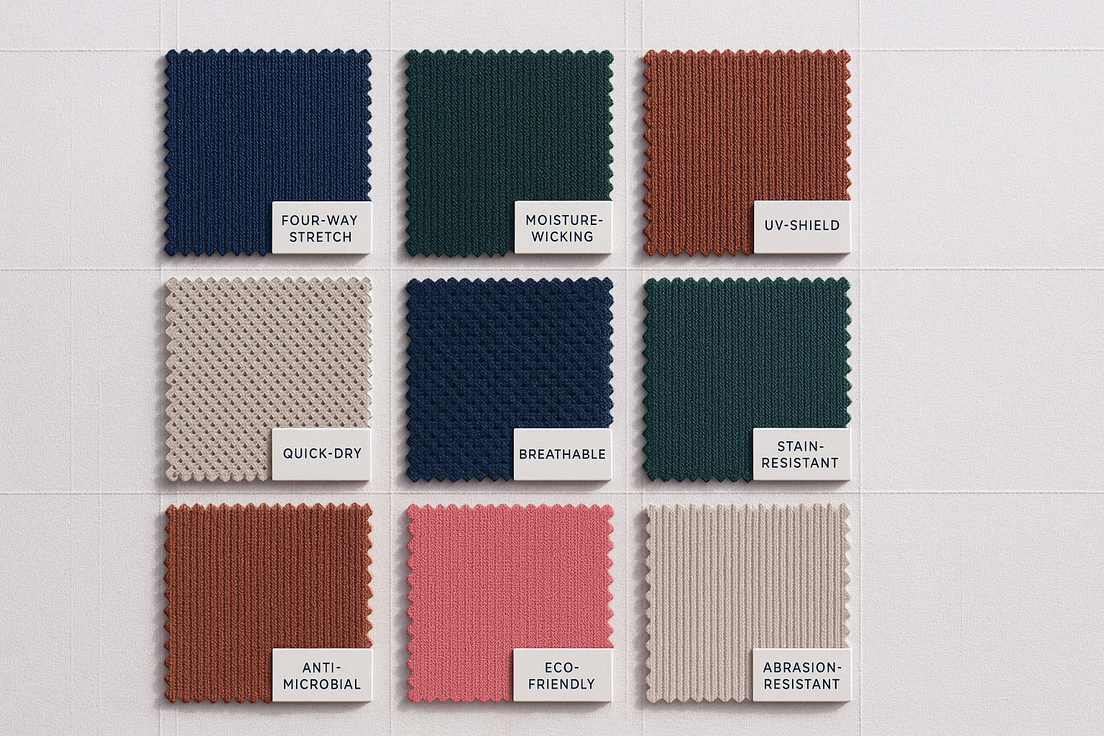
You wouldn’t wear the same shoes for dressage and cross-country. So why wear the same shirt?
Dressage: Precision and Poise
You need a clean, crisp look with subtle stretch. We recommend TENCEL™-polyester blends or fine microfiber with a slight sheen. Fit should be tailored but not tight. Bonus points for hidden ventilation under the arms.
Show Jumping & Eventing: Power and Movement
You’re moving fast, leaning forward, stretching. You need 4-way stretch, reinforced seams, and maximum breathability. Nylon-spandex blends are our top pick. One rider told us she switched from cotton to our FlexWeave™ fabric and “finally stopped adjusting her sleeves mid-course.”
Trail Riding: Comfort and Protection
Sun, bugs, wind. You need UPF 50+, lightweight fabric, and maybe even insect-repellent treatment. Microfiber with mesh panels works great. Avoid anything too tight—chafing on a long ride is no joke.
Coaching & Training: All-Day Wear
You’re on your feet for 8+ hours. Odor control and wrinkle resistance are key. Our Pro-Tech™ fabric with silver-ion treatment is a coach favorite. One instructor in Florida said, “I wear mine five days a week. Still looks sharp.”
Competitive Showing: Stand Out, Stay Cool
You want color that pops, fabric that doesn’t wrinkle, and breathability under layers. High-tenacity polyester with a smooth finish is ideal. Custom embroidery? Yes, please.
The Hidden Cost of Cheap Custom Equestrian Shirts
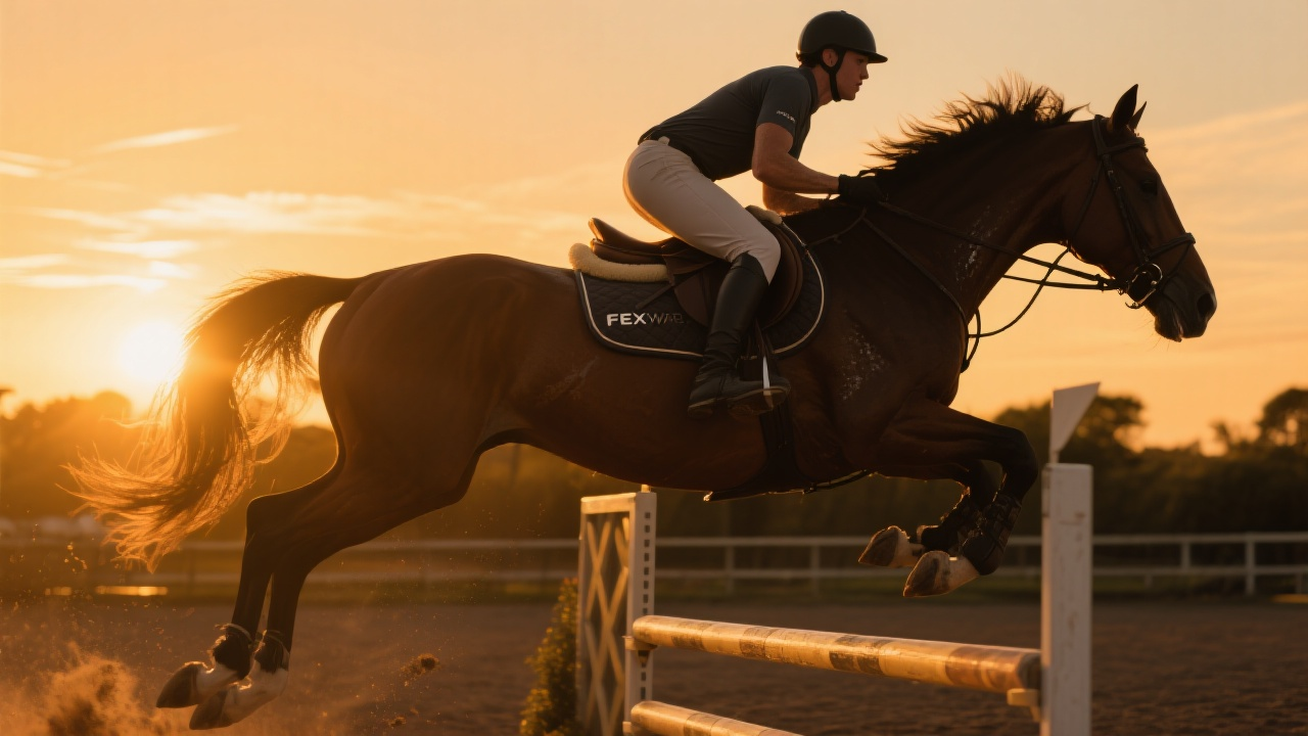
Here’s a story: A riding club in Virginia ordered 20 custom shirts from a big-box online printer. Looked great on screen. Arrived in two weeks. By the third show, the logos were peeling, the shirts were fading, and one rider’s sleeve ripped during a mounting demonstration.
They reached out to us. We asked: What was your priority—price or performance?
They said price.
We said: You just found out why.
Cheap custom shirts often use low-grade blanks—basic athletic tees or cotton blends not designed for equestrian use. Then they slap on a logo and call it a day. But true custom equestrian shirts are built from the ground up: fabric, cut, seam placement, branding.
At Fexwear, we don’t start with a catalog. We start with a conversation. What’s your discipline? Your climate? Your team colors? Your budget? Then we recommend fabrics that last.
Because here’s the reality: A $25 shirt that falls apart in a season costs more than a $65 shirt that lasts three years.
Sustainability in Equestrian Apparel: It’s Not a Trend, It’s a Responsibility
I’ll be honest—I used to think “eco-friendly” was just marketing. Then I saw the stats: the fashion industry produces 10% of global carbon emissions. And synthetic fabrics? They shed microplastics every time you wash them.
So we asked: Can performance and sustainability coexist?
Yes. But it takes effort.
We now use 100% recycled polyester in three of our five fabric lines. It’s made from plastic bottles—about 8 per shirt. Same performance, lower footprint.
We also offer TENCEL™ and OEKO-TEX® certified fabrics, meaning no harmful dyes or chemicals.
Is it more expensive? Slightly. But riders are willing to pay more for eco-conscious riding gear. One customer said, “I ride to connect with nature. I don’t want my clothes harming it.”
How to Care for Your Performance Riding Shirts (So They Last)
You wouldn’t pour diesel in a Ferrari. So why ruin a high-performance shirt with fabric softener?
Here’s the golden rule: Cold water, gentle cycle, no softeners, air dry or low heat.
Fabric softeners coat fibers and kill moisture-wicking properties. Dryer sheets? Same issue.
Wash inside out to protect prints and embroidery.
And if your shirt has odor-resistant treatment, avoid bleach and harsh detergents. They break it down.
Store flat or hung—never crumpled in a gym bag for days.
Do this, and your Fexwear shirt can last 3–5 years of regular use. Skip it? You’ll be replacing it every season.
Why Custom Fit Matters More Than You Think
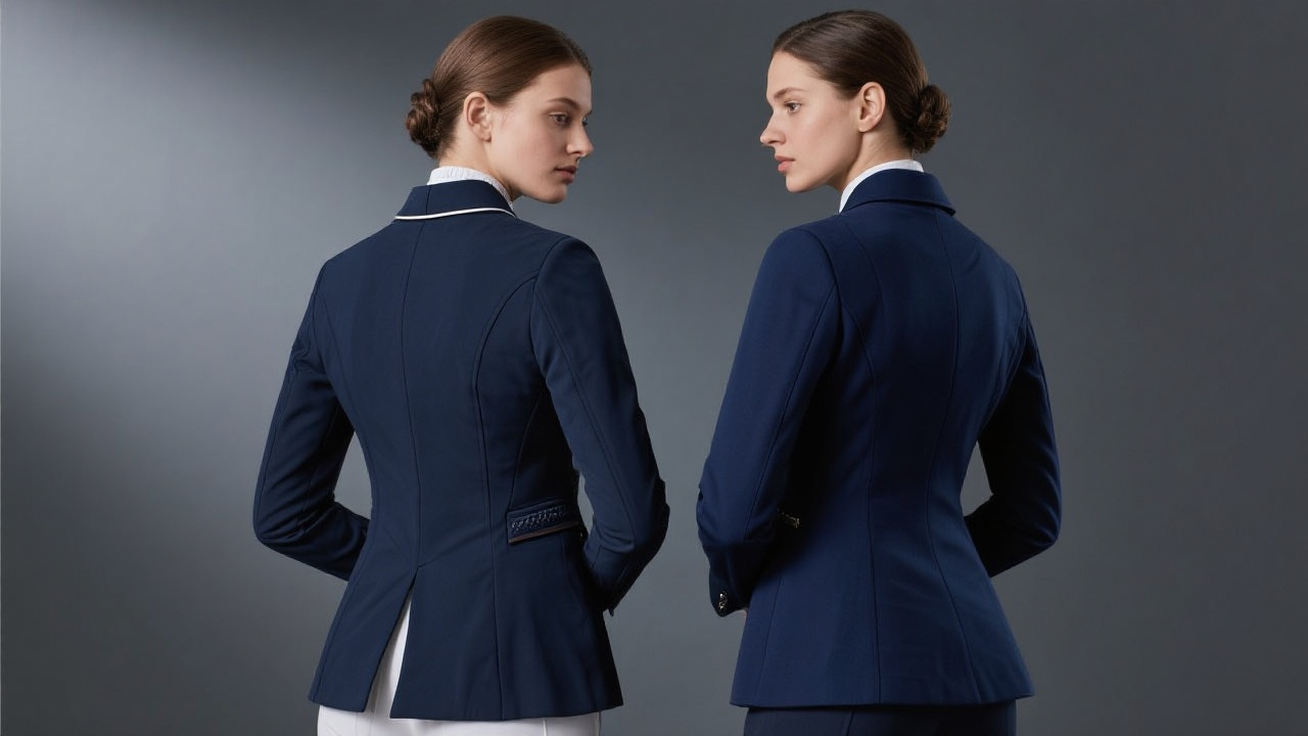
A riding shirt should fit like a second skin—close but not tight, flexible but not baggy.
Off-the-rack sizes? Rarely cut for riders. Broad shoulders, long torsos, athletic builds—they don’t fit standard charts.
That’s why we offer custom sizing. Not just XS–XXL. We adjust sleeve length, torso height, chest width.
One rider, a tall dressage competitor, said, “Every other brand’s ‘tall’ size still rides up. Fexwear finally got it right.”
Custom fit isn’t vanity. It’s function. A shirt that fits right doesn’t ride up, doesn’t restrict, doesn’t distract.
The Fexwear Difference: Built by Riders, for Riders
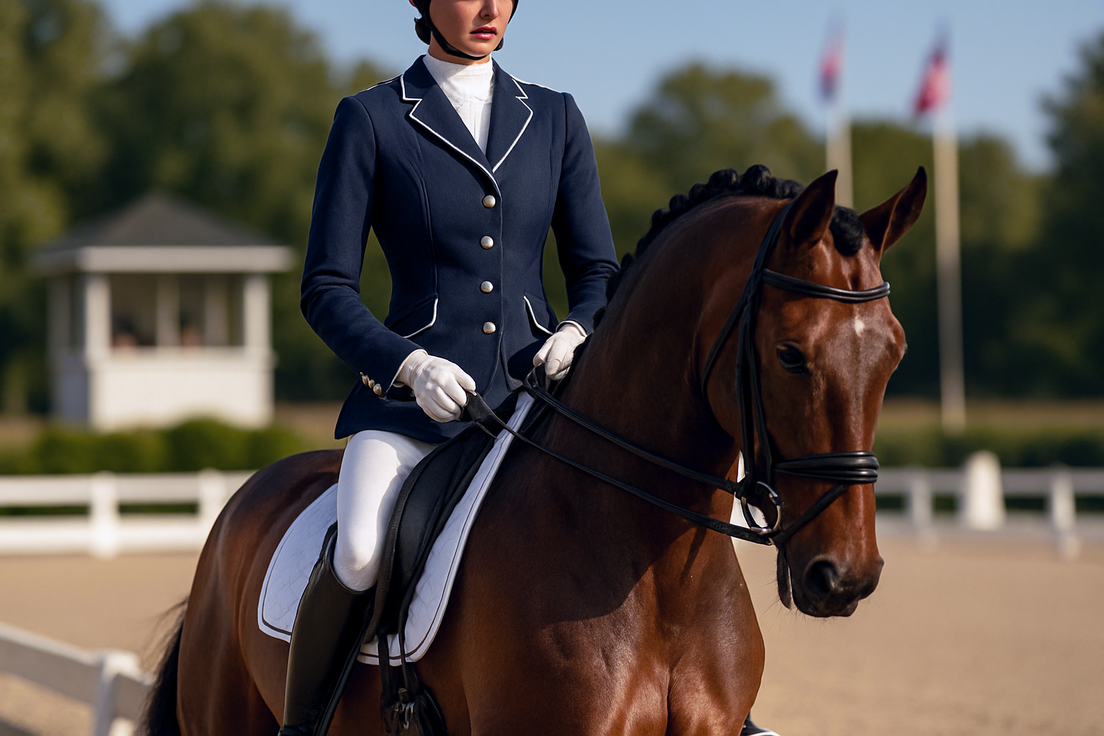
We’re not a fashion brand that discovered horses. We’re riders. Trainers. Competitors. We’ve felt the frustration of a bad shirt.
So we built Fexwear to solve real problems.
Our Pro-Tech™ fabric? Tested in arenas, barns, and clinics across the U.S. It wicks, stretches, resists odor, blocks UV, and stays sharp after 50+ washes.
Our custom design process? Simple. You send us your logo, colors, ideas. We send mockups. You tweak. We produce.
No minimums. No hidden fees. No long waits.
And we listen. When a team asked for reflective piping for night safety, we added it. When a coach wanted hidden pockets for treats or gloves, we designed them.
That’s the Fexwear difference: we build what riders actually need.
Real Riders, Real Results: Stories from the Field
- “I switched to Fexwear for my training barn. My students noticed the difference immediately—less adjusting, more focus.” – Sarah, Trainer, TX
- “Wore my custom shirt at Rolex. Stayed dry, stayed cool, stayed confident.” – Mark, Eventer, KY
- “Our team looks professional now. Sponsors love it.” – Jen, Riding Club Director, CO
These aren’t paid testimonials. They’re real emails we’ve received.
FAQs: Your Burning Questions, Answered
Q: Are custom equestrian shirts worth the investment?
A: If you ride regularly, absolutely. A well-made custom shirt lasts years, performs better, and boosts your confidence. Think of it as riding gear, not just clothing.
Q: Can I get custom shirts in youth sizes?
A: Yes. We offer full size ranges, including youth and petite options. Perfect for junior teams.
Q: How long does it take to receive custom shirts?
A: Typically 2–3 weeks from design approval. Rush options available.
Q: Do your fabrics work in cold weather?
A: Yes. We offer thermal blends and base layers. Layering is key.
Q: Are your shirts breathable for summer riding?
A: Extremely. Our CoolVent™ line uses mesh zones and moisture-wicking tech to keep you dry even in 95°F heat.
Conclusion: Your Shirt Should Serve You, Not the Other Way Around
At the end of the day, riding is about connection—between you and your horse, between effort and grace. The last thing you should be thinking about is a shirt that’s riding up, soaking through, or falling apart.
Custom equestrian shirts aren’t a luxury. They’re a tool. And like any tool, they should be built for the job.
At Fexwear, we believe performance, comfort, and style aren’t trade-offs. They’re essentials. Whether you’re a weekend rider or a competitive athlete, you deserve apparel that keeps up.
So stop settling for “good enough.”
Stop wearing clothes that fight your ride.
Start wearing gear that fuels it.
Ready to design your custom equestrian shirt?
Visit fexwear.com and request a free fabric swatch kit.
See—and feel—the difference for yourself.
Let’s Keep the Conversation Going
What’s your biggest frustration with riding apparel?
Is it the fit? The fabric? The fading logos?
Drop a comment below or tag us on social media with your barn’s custom shirt setup.
We read every message—and we’re always looking for ways to improve.
Because at Fexwear, we’re not just making shirts.
We’re building a community of riders who demand better.

